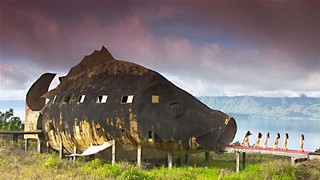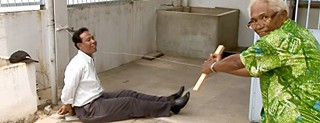Making a 'Killing'
Joshua Oppenheimer on the half-decade he spent filming for 'The Act of Killing'
By Richard Whittaker, Fri., Aug. 9, 2013
An old man lies sleeping and whimpering on a bed, plagued by bad dreams – dreams of blood, dreams of decapitation, dreams of murder and genocide. They are dreams of his life. But he was not the victim. In 1960s Indonesia, Anwar Congo was a street thug who became a death squad leader. In The Act of Killing, he and his fellow state-sanctioned murderers gleefully reenact their sins. While audiences may see him as a blood-drenched criminal, to many in his country, those same actions make him a hero. For documentarian Joshua Oppenheimer, Congo gives an insight into the terrible, almost inconceivable story behind modern Indonesia. He said, "It is like Nazi Germany 40 years after the Holocaust if the Nazis were still in power."
Modern Indonesia is a blind spot for many in the global community, but it has in its past some of the most terrible lines in the pages in history. In 1965, Gen. Suharto began a power grab, mounting a bloody purge of his enemies by declaring them Communists. Suddenly, men like Congo – a petty gangster and ticket scalper – were given carte blanche to murder as many "enemies of the state" as they could. No one really knows how many people died in the bloodletting, but estimates range from 500,000 to as high as 3 million. Then in 1968, Suharto became president, and his murderous cadre suddenly became the establishment. Forty years later, Congo's twitching dreams are the closest he has ever come to a trial.
That scene may be among the most telling moments in The Act of Killing, but it is not the most surreal. In a radical departure from the standard Robert Greenwald school of talking-head documentaries, Oppenheimer and his co-director Christine Cynn got Congo and his friends to reenact their crimes for the camera, however they saw fit. They saw themselves as suave heroes, birthed from the Hollywood classics for which Congo used to scalp tickets when he was a young street thug. That self-image is reflected in the vignettes they create. Dancing girls sway in front of a giant fish like an opium-doused Busby Berkeley routine. The murderers dress as Bogart-style gangsters, cleaning the streets. In one chilling scene, they burn the village to save it, Platoon-style, and are greeted by cheering crowds. It is the story of the massacres from their viewpoint, no matter how subjective, self-serving, and ultimately self-incriminating. Oppenheimer explained what he told them: "You want to show me what you've done. Show me what you've done in whatever way you've wished, and I will film the process in any way you wish. I will film any reenactments that you stage, any demonstrations of how you killed."
The result mixes bizarre re-creations with "behind the scenes" footage and interviews, creating something that is as much a making-of as a film in its own right. Before their Indonesian adventure, Oppenheimer and Cynn were based in London, trying to find new approaches to truth-telling. "We had been experimenting with documentary methods that would provide insight into how people see themselves," Oppenheimer said. The summation of their dabbling has been given the blessing of two of the godfathers of experimental documentary, with both Errol Morris (The Thin Blue Line) and Werner Herzog (Grizzly Man, Into the Abyss) praising the film for rewriting the meaning and potential of a documentary; they're both on board as executive producers. By making the subjects the directors, Oppenheimer said: "The viewer enters the violence with them. ... It allows people to see the multiple stories that we tell about ourselves. Half-remembered, secondhand, third-rate stories that we identify with, fantasies that make us who we are."
The Act of Killing is the product of a decadelong hunt for Oppenheimer: a quest to answer how a small-time hoodlum like Congo could become an unindicted mass murderer. In 2001, he and Cynn were interviewing plantation workers trying to unionize in post-Suharto Indonesia for their documentary The Globalisation Tapes. They traveled 40 miles outside the city of Medan, to a Belgian-owned oil palm plantation. "We were supposed to document the violence of globalization," he said. "The women workers were forced to spray an herbicide that was destroying their livers and killing them in their 40s." Yet they were afraid to start a union because they feared a second genocide. He said, "They were the children and grandchildren of people who had been in a strong plantation workers union, but because they were in a union [and] had been accused of being Communist sympathizers by the military, they were put in concentration camps and dispatched to be killed."
Word spread that the pair were delving into the genocide, and they were quickly and repeatedly harassed by the military. "They would take our equipment, they would take our tapes, they would detain us," Oppenheimer said. "It was very difficult to get anything taped, and it was very frightening, especially for the survivors."
This was a dangerous endeavor: On The Act of Killing's credits, 20 members of the crew – including one of the co-directors – are listed as anonymous, for fear of retribution. Concerned for their safety, Oppenheimer traveled to Jakarta to talk with human rights groups about how he could continue. "All of those human rights advocates and even the survivors themselves said, 'No, you're on to something extremely important.'" This was not just about explaining what had happened in Indonesia to the wider world; he also wanted to create "something that exposes Indonesians themselves to something they know but have been afraid to speak up about."
The turning point came during the filming of The Globalisation Tapes. One of the men who took part in the systematic massacres still lived in the same village as his victims. Rather than fearing retribution, Oppenheimer said, "He was very boastful about what he had done, immediately open about it." This opened a new door to the hidden history. "One of the survivors said: 'You've heard one perpetrator boast. Film more perpetrators. From them, you will find what happened. In their boasting, the audience will see why we're so afraid and the nature of the impunity they enjoy.'" Over five years, he worked his way up the food chain, from local enforcers to retired military officers in Jakarta, even to former CIA officers living back in the U.S. So when Oppenheimer finally met Congo in 2005, he wasn't the first interviewee, or even the 10th. "He was the forty-first executioner I filmed," said Oppenheimer.
When it came to the reenactments, there was no deceit, Oppenheimer said: "The method was not an elaborate lure to get them to open up. The method was a response to their openness." Congo saw each re-creation after it was shot, even while some of his fellow executioners were starting to worry about how much they were being exposed. "We see this process within the film, where [Congo's fellow death squad leader] Adi Zulkadry says, 'If we succeed in making the film, it will turn history on its head.'"
Much of the film is about how Congo and his allies mentally process their own bloodstained legacy, and that was essential for Oppenheimer. For him, simply condemning them as evil is "reductionist. ... You can say what they did was evil, but you must separate that from the human being, who is much more complex than that." He said, "If anybody asks me, 'Isn't it wrong to humanize them?' there's a very simple answer. They are human. If we want to understand how human beings do these things, why we do them, what it means when we do them, we have to approach them as humans."
Yet the director paid a psychic toll. He spent year after year hanging around with murderers as they gleefully demonstrated how to turn decapitation into a production line process. "It was painful," said Oppenheimer, who admitted that he had nightmares during filming. He ended up walking "a tightrope of revulsion and empathy," and he attempts to reconstruct those emotional contradictions for viewers. "In the film, I've tried to use humor just to get the audience's guard down just before some of the most horrific moments. These moments are meant to replicate for the viewer what I went through."
The Act of Killing opens in Austin on Aug. 9 at the Alamo Lakeline and the Alamo Slaughter Lane. See Film Listings for showtimes and review.











